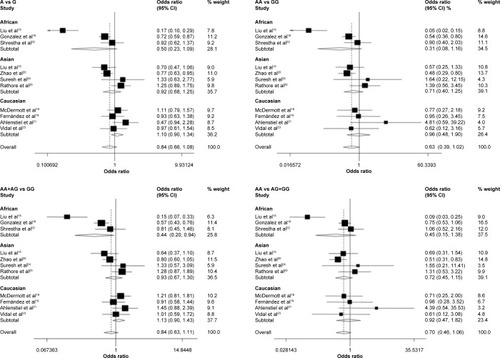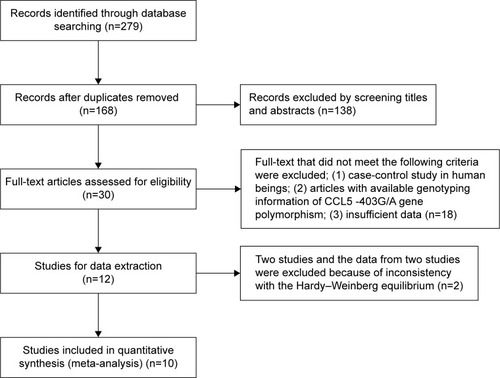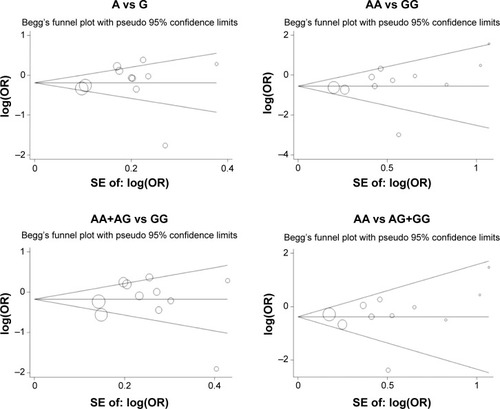Abstract
Background
The association between chemotactic chemokine ligand 5 (CCL5) -403G/A gene polymorphism and human immunodeficiency virus-1 (HIV-1) infection has been illustrated among several case-control studies, but the conclusions are still inconsistent. Here we performed a meta-analysis to estimate the association.
Methods
The published studies based upon the association between CCL5 -403G/A polymorphism and HIV-1 infection were retrieved from PubMed, Embase, and China National Knowledge Infrastructure database. Quantitative synthesis, including pooled odds ratios (ORs) and 95% confidence intervals (CIs), was performed for all genetic models.
Results
A total of ten studies consisting of 5,127 subjects were included for this meta-analysis. There was no association found between -403G/A polymorphism and HIV-1 infection in the overall analysis under any genetic models. Further stratified by ethnicity, our analysis showed that -403A/A polymorphism significantly decreased the susceptibility to HIV-1 infection in three models: the dominant model (AA+AG vs GG: OR =0.44, 95% CI =0.21–0.94) among Africans, the homozygous model (AA vs GG: OR =0.62, 95% CI =0.242–0.90), and the recessive model (AA vs GG+AG: OR =0.62, 95% CI =0.45–0.93) among Asians.
Conclusion
We found that only Asians and Africans with CCL5 -403A/A polymorphism could be resistant to HIV-1 infection. However, further studies should be performed to evaluate this association on ethnic basis against control groups consisting of individuals who have once been exposed to HIV-1 but are seronegative.
Introduction
The human immunodeficiency virus (HIV) is a retrovirus that infects the cells of the immune system, destroying and impairing their function. As reported by World Health Organization, there were approximately 35.3 million people living with HIV in 2012 (http://www.who.int/mediacentre/factsheets/fs360/en/). HIV infection has been one of the most serious public health threats all over the world. However, the risk and natural course of HIV-1 disease are different among individuals.Citation1 It is well known that the genetic variants could affect the susceptibility to HIV-1 infection, transmission, disease progression, and antiviral therapy.Citation2 Genomic studies have shown that the allelic variants of chemokine receptors and their natural ligands that are related to HIV-1 entry can affect the susceptibility and progression of HIV-1 infection.Citation3–Citation6
Chemotactic chemokine ligand 5 (CCL5), which is also called regulated on activation, normal T cell expressed and secreted (RANTES), belongs to the family of chemotactic chemokines. As an important chemokine, CCL5 is mostly involved in immune regulatory and inflammatory activities owing to its ability to recruit, activate, and co-stimulate T-cells and monocytes.Citation7,Citation8 By conjugating to macrophage inhibitory protein-1α (MIP-1α) and -1β (MIP-1β), CCL5 plays a critical protective role in HIV-1 infection by blocking the access of the HIV-1 envelope glycoprotein gp120 to chemotactic chemokine receptor 5 (CCR5).Citation9 -403G>A (rs2107538) polymorphism, which has been identified in the promoter region of the gene CCL5, is associated with transcriptional activity, and subsequently affects its protein expression in human cell lines,Citation10 so that -403G/A polymorphism is considered a potential susceptibility factor to HIV-1 infection based upon its function.
Up to now, many reports have been published evaluating the association between CCL5 -403G/A polymorphism and HIV-1 infection among different ethnic populations, but the results are in conflict. Several possible factors contribute to this inconsistency, including sample size, ethnic diversity, and others. Meta-analysis conducted by pooling the data from different studies would provide better statistical power to address the above-mentioned shortcomings posed by different studies, especially those due to an inadequate sample size.Citation11
Hence, in order to provide a precise and comprehensive evaluation of the association between CCL5 -403G/A polymorphism and the risk of HIV-1 infection, we performed a meta-analysis by pooling data from published studies.
Materials and methods
Literature search strategy
We retrieved documents from major electronic databases, including PubMed, Embase web database, and China National Knowledge Infrastructure, using various combinations of the following keywords: “HIV or HIV-1 or AIDS or human immunodeficiency viruses,” “RANTES or CCL5 or chemotactic chemokine ligand”, and “polymorphism or polymorphisms or mutation or variant” (last search update October 1, 2014). We then evaluated the potential studies by reviewing their titles and abstracts, and the documents were retrieved in duplication by two independent investigators (He and Li) according to the search strategy.
Inclusion and exclusion criteria
We examined the titles and abstracts of the articles to ensure that all articles included in the current meta-analysis met all the following three inclusion criteria: (a) case-control studies were conducted to evaluate the association between CCL5 -403G/A polymorphism and susceptibility to HIV-1 infection, and the controls were healthy individuals without a history of exposure to HIV-1, (b) the studies provided distribution data of -403G/A polymorphism in the case-control population, and (c) the original articles were published either in English or in Chinese. In addition, we selected the studies with the largest sample size when there was a subject overlap among different studies. Some studies were excluded because they: (a) were either merely reviews or irrelevant to human subjects; (b) overlapped with other studies in terms of data; or (c) only involved cases or control group.
Data extraction
According to the inclusion and exclusion criteria listed above, two investigators (He and Li) reviewed and extracted the information from all eligible articles independently. Disagreements were resolved by discussion between the two investigators. Another investigator (Tang) was invited to the discussion if they did not reach an agreement. The following details of eligible articles were collected: the first author, year of publication, original country, ethnicity, number of HIV-1 patients and healthy individuals, and the distributions of CCL5 -403G/A polymorphism in all subjects.
Statistical analysis
We used crude odds ratios (ORs) with their 95% confidence intervals (CIs) to evaluate the strength of association between the gene CCL5 -403G/A polymorphism and the risk of HIV-1 infection. The allelic model (A vs G), homozygous model (AA vs GG), dominant model (AA+AG vs GG), and recessive model (AA vs AG+GG) were used for quantitative analysis. Further, stratification analysis was performed based on ethnicity. Heterogeneity between studies was assessed by χ2-based Q-test. We used a fixed-effect model (Mantel–Haenszel) to evaluate the summary ORs if the P-value for heterogeneity was more than 0.05, indicating an absence of heterogeneity. Otherwise, we used the random-effect model (DerSimonian and Laird) to evaluate the summary ORs. We performed the Hardy–Weinberg equilibrium (HWE) test to assess the departure of frequencies of CCL5 polymorphism from the expected values by χ2-test in controls. Sensitivity analysis was performed by deleting one study at once to test the stability of the pooled results. We assessed the possible publication bias by Begg’s funnel plot and Egger’s test.
The Stata software package (version 9.2; College Station, TX, USA) was used for all statistical tests in this meta-analysis. A result was defined as statistically significant when the P-value was less than 0.05.
Results
Study characteristics
As the flow chart in shows, a total of 279 articles were retrieved through an initial search of the selected electronic databases. After screening the titles and abstracts, 14 of the 279 articles were obtained, and further data were extracted from these 14 articles. During the extraction of data, one study was excluded due to insufficient data on the distribution of CCL5 -403G/A polymorphism,Citation12 and another study was excluded on account of duplicate data.Citation13 Further, two studies and the data from the two studies concerning Caucasians were excluded because of inconsistency with HWE.Citation14–Citation17 Finally, a total of ten studies were considered suitable for meta-analysis.Citation15,Citation16,Citation18–Citation25 Among them, there were four studies of Asians, four studies of Caucasians, and three studies of Africans. One of the studies involved both Asians and Africans.Citation15 The total number of samples was 5,127, which consisted of 2,306 HIV-1 patients and 2,821 healthy controls. The details of eligible studies are listed in .
Table 1 Major characteristics of the studies included in this meta-analysis
Quantitative synthesis
The main results of this meta-analysis and the heterogeneity test are shown in and . In the overall analysis, no association between the -403G/A polymorphism and the risk of HIV-1 infection were observed in any genetic models. When further stratified by ethnicity, the analysis showed that the -403A/A polymorphism significantly decreased the risk of HIV-1 infection in the dominant model (AA+AG vs GG: OR =0.44, 95% CI =0.21–0.94, P=0.002 for heterogeneity test) among Africans, also in the homozygous model (AA vs GG: OR =0.62, 95% CI =0.242–0.90, P=0.175 for heterogeneity test), and the recessive model (AA vs GG+AG: OR =0.62, 95% CI =0.45–0.93, P=0.261 for heterogeneity test) among Asians.
Figure 2 Forest plot analysis for assessing HIV-1 infection risk associated with CCL5 -403G/A polymorphism under all genetic models by using the random-effect model.

Table 2 Results of CCL5 -403G/A polymorphism on the risk of HIV-1 infection
Sensitivity analysis
Sensitivity analysis was performed to assess the stability of the pooled ORs in the total population and all the subgroups under all genetic models. The results became statistically significant (OR =0.58, 95% CI =0.36–0.94, P=0.002 for the heterogeneity test) in the homozygous model in the overall analysis, when one study of German subjects (Caucasian) was deleted.Citation21 However, the result remained stable for other genetic models.
Publication bias
The publication bias was evaluated by Begg’s rank correlation method and Egger’s weighted regression method. The visual inspection of funnel plot asymmetry is shown in , which presents no significant publication bias in any genetic models.
Discussion
Meta-analysis offers a powerful method to synthesize similar types of data obtained from independent studies with similar targets.Citation26 Up to now, the association between chemokines and their receptor gene polymorphisms and the risk of HIV-1 infection has been investigated by many studies. A recent meta-analysis suggests that the RANTES -28G allele might play a role in the resistance to HIV-1 infection among Asians,Citation27 and a lower copy number of CCL3L1 might increase the susceptibility to HIV-1 infection,Citation28 while other two genes, polymorphisms CCR2-Val64Ile and CCR5-Δ32, have not been shown to have any association with HIV-1 infections.Citation29,Citation30
The association between CCL5 -403G/A polymorphism and the risk of HIV-1 infection had been presented in many studies, but the results were inconsistent. Here we performed a meta-analysis to find a more definitive conclusion. Finally, a total of ten studies composed of 5,127 subjects were pooled for the analysis. We found that -403A/A decreased the risk of HIV-1 infection in the dominant model among Africans, also in the homozygous model, and the recessive model among Asians.
The interactions between the viral envelope glycoproteins, the CD4 receptor, and HIV-1 coreceptors are critical for the entry of HIV-1 into CD4+ cells. As the primary HIV-1 coreceptors, the chemokine receptors, CCR5 and CXCR4, can emerge during the later stages of HIV-1 infection by using their functional regions, R5 in HIV-1 strains and Cy in X4-HIV-1 strains, respectively. By competitive binding and downregulation of CCR5, CCL5 can inhibit HIV-1 cell entry and replication.Citation31 It has also been reported that variants in the HIV-1 coreceptors and their natural ligands have been shown to change HIV-1 susceptibility, transmission, and progression.Citation3,Citation4 At the genetic level, the mutant allele -403A can decrease the rate of CD4+ T cell, and demonstrated increased promoter activity when tested by luciferase reporter gene assay in both U937 and Jurkat cell lines.Citation10,Citation13 Here is the probable mechanism to explain that -403A/A could be resistant to HIV-1 infection.
Heterogeneity is very common when the meta-analysis is conducted between the genetic association studies. In this study, we also found inter-study heterogeneity in the overall analysis. Several factors contribute to heterogeneity, such as the different genetic backgrounds of subjects, and the function and frequency of gene polymorphisms vary among different ethnic individuals.Citation32 Although the meta-analysis is a powerful statistical method, limitations are still inevitable. First, we included studies published in English and Chinese only, and the studies were retrieved from selected electronic databases. Relevant reports published in other languages and indexed in other electronic databases might have been ignored in this study. Second, sensitivity analysis demonstrated unstable results; thus, we should draw conclusions cautiously sometimes. Third, publication bias could not be excluded. The most common reason for publication bias is that the negative results in genetic association studies are hard to be published. In this study, we could get sufficient data from one study because of the negative result.Citation32 Fourth, gene–gene and gene–environment interactions are well known to affect host susceptibility to HIV-1 infection. In fact, many genes and their variants have been reported to be associated with HIV-1 infection, but enough evidence is not available to eliminate these confounding factors. Socioeconomic factors also play a critical role in the prevalence of HIV-1 infection and its progression. Finally, the route of transmission could be essential for the impact of polymorphisms in HIV-transmission. The HIV-1 exposed but seronegative individuals are at high risk of HIV infection, including commercial sex workers, people with hemophilia, discordant couples, intravenous drug users, and infants born to HIV-infected mothers. We had retrieved no more than 211 HIV-exposed but seronegative individuals consisting of 50 controls with hemophilia,Citation13 82 heterosexual contact individuals,Citation24,Citation25 and 79 male homosexuals.Citation18 It is not suitable to pool the data for meta-analysis. Finally, the controls in this study were almost healthy individuals.
Conclusion
In conclusion, this meta-analysis involving ten case-control studies suggests that the CCL5 -403A/A genotype might be resistant to HIV-1 infection among Asians and Africans. While there are few limitations as shown above, we should make this conclusion cautiously. Further studies should be performed to evaluate this association among different ethnic populations against controls who have HIV-1-exposed history but remain seronegative.
Acknowledgments
We sincerely thank Dr Yao at the Nanchang University for extending help in revising the article draft.
Disclosure
The authors report no conflicts of interest in this work.
References
- PantaleoGImmunology of HIV infectionRes Immunol199714864174199443581
- KaurGMehraNGenetic determinants of HIV-1 infection and progression to AIDS: immune response genesTissue Antigens200974537338519765261
- WinklerCModiWSmithMWGenetic restriction of AIDS pathogenesis by an SDF-1 chemokine gene variant. ALIVE Study, Hemophilia Growth and Development Study (HGDS), Multicenter AIDS Cohort Study (MACS), Multicenter Hemophilia Cohort Study (MHCS), San Francisco City Cohort (SFCC)Science199827953493893939430590
- MartinMPDeanMSmithMWGenetic acceleration of AIDS progression by a promoter variant of CCR5Science19982825395190719119836644
- AnPMartinMPNelsonGWInfluence of CCR5 promoter haplotypes on AIDS progression in African–AmericansAIDS200014142117212211061652
- QianYSunHLinKShiLShiLChuJDistribution of CCR5-Delta32, CCR2-64I, SDF1-3′A, CX3CR1-249I, and CX3CR1-280M in Chinese populationsAIDS Res Hum Retroviruses200824111391139719032065
- GerardCRollinsBJChemokines and diseaseNat Immunol20012210811511175802
- LusterADChemokines – chemotactic cytokines that mediate inflammationN Engl J Med199833874364459459648
- MackMLuckowBNelsonPJAminooxypentane-RANTES induces CCR5 internalization but inhibits recycling: a novel inhibitory mechanism of HIV infectivityJ Exp Med19981878121512249547333
- NickelRGCasolaroVWahnUAtopic dermatitis is associated with a functional mutation in the promoter of the C-C chemokine RANTESJ Immunol200016431612161610640782
- CohnLDBeckerBJHow meta-analysis increases statistical powerPsychol Methods20038324325314596489
- JangDHChoiBSKimSSThe effects of RANTES/CCR5 promoter polymorphisms on HIV disease progression in HIV-infected KoreansInt J Immunogenet200835210110518218038
- LiuHChaoDNakayamaEEPolymorphism in RANTES chemokine promoter affects HIV-1 disease progressionProc Natl Acad Sci U S A19999684581458510200305
- LiuXWangFJinLCharacterization of variants in the RANTES gene in Han and Uiygur Chinese population and its implication in HIV-1 infectionMed J Chin PLA2003629489491
- LiuHShiodaTNagaiYDistribution of HIV-1 disease modifying regulated on activation normal T cell expressed and secreted haplotypes in Asian, African and Caucasian individuals. French ALT and IMMUNOCO Study GroupAIDS199913182602260310630535
- GonzalezEDhandaRBamshadMGlobal survey of genetic variation in CCR5, RANTES, and MIP-1alpha: impact on the epidemiology of the HIV-1 pandemicProc Natl Acad Sci U S A20019895199520411320252
- LiHLiuTJHongZHGene polymorphisms in CCR5, CCR2, SDF1 and RANTES among Chinese Han population with HIV-1 infectionInfect Genet Evol2014249910424650919
- McDermottDHBeecroftMJKleebergerCAChemokine RANTES promoter polymorphism affects risk of both HIV infection and disease progression in the Multicenter AIDS Cohort StudyAIDS200014172671267811125885
- FernándezRMBorregoSMarcosIRubioALissenEAntiñoloGFluorescence resonance energy transfer analysis of the RANTES polymorphisms -403G →A and -28G →C: evaluation of both variants as susceptibility factors to HIV type 1 infection in the Spanish populationAIDS Res Hum Retroviruses200319534935212803993
- ZhaoXYLeeSSWongKHEffects of single nucleotide polymorphisms in the RANTES promoter region in healthy and HIV-infected indigenous ChineseEur J Immunogenet200431417918315265023
- AhlenstielGIwanANattermannJDistribution and effects of polymorphic RANTES gene alleles in HIV/HCV coinfection – a prospective cross-sectional studyWorld J Gastroenterol200511487631763816437690
- ShresthaSStrathdeeSAGalaiNBehavioral risk exposure and host genetics of susceptibility to HIV-1 infectionJ Infect Dis20061931162616323127
- VidalFPeraireJDomingoPChemokines and Long-Term Nonprogressive HIV01 Infection Study GroupPolymorphism of RANTES chemokine gene promoter is not associated with long-term nonprogressive HIV-1 infection of more than 16 yearsJ Acquir Immune Defic Syndr2006411172216340468
- SureshPWanchuASachdevaRKBhatnagarAGene polymorphisms in CCR5, CCR2, CX3CR1, SDF-1 and RANTES in exposed but uninfected partners of HIV-1 infected individuals in North IndiaJ Clin Immunol200626547648416865553
- RathoreAChatterjeeASivaramaPYamamotoNSinghalPKDholeTNAssociation of RANTES -403 G/A, -28 C/G and In1.1 T/C polymorphism with HIV-1 transmission and progression among North IndiansJ Med Virol20088071133114118461620
- IoannidisJPRosenbergPSGoedertJJO’BrienTRCommentary: meta-analysis of individual participants’ data in genetic epidemiologyAm J Epidemiol2002156320421012142254
- GongZTangJXiangTAssociation between regulated upon activation, normal T cells expressed and secreted (RANTES) -28C/G polymorphism and susceptibility to HIV-1 infection: a meta-analysisPLoS One201384e6068323577146
- LiuSYaoLDingDZhuHCCL3L1 copy number variation and susceptibility to HIV-1 infection: a meta-analysisPLoS One2010512e1577821209899
- DingDLLiuSJZhuHZAssociation between the CCR2-Val64Ile polymorphism and susceptibility to HIV-1 infection: a meta-analysisMol Med Rep20114118118621461583
- LiuSKongCWuJYingHZhuHEffect of CCR5-Delta32 heterozygosity on HIV-1 susceptibility: a meta-analysisPLoS One201274e3502022496885
- BergerEAMurphyPMFarberJMChemokine receptors as HIV-1 coreceptors: roles in viral entry, tropism, and diseaseAnnu Rev Immunol19991765717700
- BamshadMWoodingSPSignatures of natural selection in the human genomeNat Rev Genet2003429911112560807


